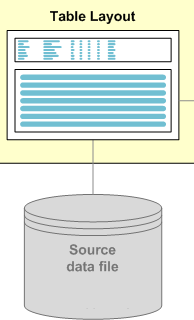Table structures
Tables are composed of two parts: the table layout that describes the data and the underlying source data file that holds the data.

Table layouts
Tables use the following metadata to create a structured interpretation of the raw data in a related source data file:
- field names
- field lengths
- field data types
- field positions
Source data files
A table’s raw data is stored in a source file that resides in one of the following locations:
- if the source file is imported with the table, the data file is stored on AX Server but does not appear in the Server Explorer
- if the source file is not imported with the table, the data
file used to create the table layout in ACL Analytics remains
on the local file system and is not associated with the AX Server table
Tip
Import a table layout without an associated source file if you plan to maintain a data feed to AX Server. In this scenario, the data feed transfers source files of a known type and structure, and you can associate the table with the data feed file in analytic scripts.
Benefits of separating raw data from tables
In AX Server, tables are distinct from source data files for the following reasons:
- performance storing source data as a separate flat file improves script and analytic performance as tables with millions of records can be analyzed in seconds
- flexibility using a single source data file, data specialists and script authors can create multiple tables and views to support a variety of audit tests
- efficiency keeping large data files on the server while associated table layouts in ACL Analytics reside on local desktop computers avoids the overhead and impracticality of downloading large files